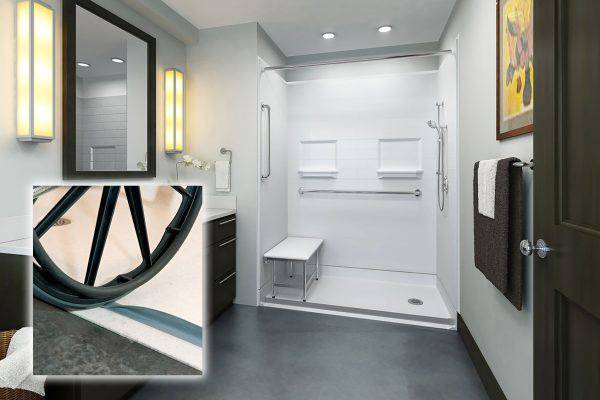The Basics
Roll-in Showers can be a perfect solution for individuals with limited mobility. They provide greater accessibility for older adults, people with physical limitations, and folks who require the use of a wheelchair. Bathing is more difficult for these people, and it can also be dangerous; hence, extra care is taken to make showering more comfortable and safe.
The one characteristic that sets the Roll-in Shower apart from other bathing configurations is that the unit has no curb or lip. The shower floor is flat and even with the bathroom floor. Like other showers, a Roll-in Shower comes in many design options and a plethora of optional accessories and add-ons.
That being said, it’s important that you know all basics of a Roll-in Shower, including features, cost, time to install, custom -vs- pre-fab, and if the functionality matches
your lifestyle.
What are the Downsides?
Most obviously, you won’t be able to take a bath. Ideally, you should have at least one bathroom with a full sized tub in your home. This not only adds to the functionality of your home but improves the appraised value. In some parts of the country, a “Full Bath” is described as a bathroom with a full sized tub. A bathroom with just a roll-in shower is deemed a “three-quarter bath.” Other things to note are the fact that small children are easier to bathe in a tub than a shower and the lack of a shower door or curtain can make for a drafty cleaning session.
What Can You Expect to Spend for a Roll-in Shower?
Due to the fact that there are so many options in styles and accessories, the price range can be a pretty wide margin. A pre-fab shower kit can be the least expensive option between $800 and $5,000. And if you have the knowledge of plumbing and framing or have a friend or family member that does, you can save the additional $800 to $5,000 in installation cost. A custom Roll-in Shower can be much more expensive than a kit due to the fact that it would need to essentially be “constructed” by a contractor or other professional. Custom tile, wall fabrication, and faucet positioning would require more expertise than the average “weekend handyman”. Costs for an installed custom Roll-in Shower could be in the range of $10,000 to $20,000.
Steps of Installation.
While the exact installation process will depend on your bathroom’s size and availability to expand, as well as the type of Roll-in Shower you are installing, here are some basic steps to give you an idea of the process.
Step 1- Measure and Choose the Right Kit
Step 2- Gather Your Tools
Step 3- Demolition
Step 4- Install the Shower Floor
Step 5- Clean the Area
Step 6- Install the Shower Walls
Step 7- Install the Shower Curb
Step 8- Waterproof the Room
Step 9- Add Fixtures
Step 10- Install the Tiles
Step 11- Install the Glass Enclosure
On average, it will just take around three to five days to replace your shower. However, if there are other things you want to be done, like re-tiling your floor or installing additional handheld shower heads, then expect the process to last longer. Also, be mindful that, like any home renovation project, unforeseen issues can cause delays as well. A second bathroom in the house is a saving grace during this process!
Maintaining a Roll-in Shower.
An exhaust vent is a true blessing when it comes to maintaining your new shower. Turning it on before you turn the water on can help remove the moisture in the air during your shower. If you aren’t lucky enough to have an exhaust fan, (make note of it for your next home reno project), you can open a window to help alleviate the excess moisture.
Using a mild daily shower spray after every shower can help keep soap scum and hard water deposits down to a minimum. There are mild cleansers on the market but there are also a ton of DIY “recipes” on the Internet. Using a squeegee after spraying your shower down will help remove any excess moisture on the walls and floor.
Every week or so use an all purpose bathroom cleaner and soft brush to clean the tiles and grout lines. Any glass panels can be cleaned using a commercial glass cleaner.
Following these simple steps will help keep your shower brand new and give you that same satisfied feeling you had the first time you stepped into your new shower.
Re(shower) cap
In summary, here are a few things to keep in mind when trying to decide whether or not a roll-in shower is right for you. First, access the bathroom to see what type/size shower will work. Second, look at your budget and plan accordingly. Be mindful that hidden costs may arise. Next, pick out your shower style and hardware set-up. (Your budget can put limitations on this.) Then prepare the space and install the shower. (Or have it installed). Lastly, keep the shower maintained to enjoy many years of safe showering!
For more information on a great Shower Package Offer, visit www.ezrampz.com/shower



